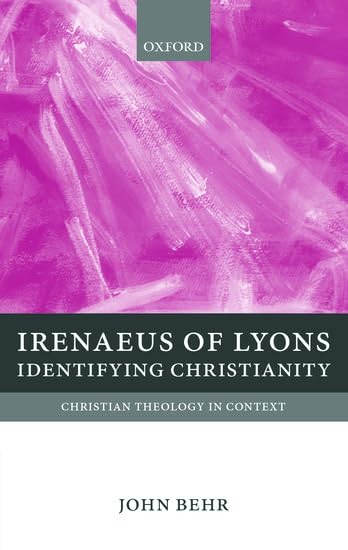Irenaeus of Lyons: Identifying Christianity
Written by John Behr Reviewed By Eric WickmanJohn Behr, perhaps best known for his works The Way to Nicaea (2001) and The Nicene Faith (2004), offers a splendid, short new work titled Irenaeus of Lyons: Identifying Christianity. Behr sees a need for this new volume on this well-studied figure since Irenaeus’s opponents, namely, Valentinian and Marcion, have recently been the subjects of numerous studies. As a result of the works of Bart Ehrman, Karen King, and David Brakke on this category of “Gnosticism,” there has been an increasing acceptance among scholars of the early church that there is no single early Christianity, but that there exist many “lost Christianities.” As the opponents of Irenaeus have undergone more sympathetic reevaluation, Behr sees a need to reevaluate Irenaeus with these more recent studies and assessments in mind.
Although occasioned by the scholarship on “lost Christianities,” Behr does not directly engage in a refutation of any particular work. He focuses his attention on enlightening his reader about Irenaeus. The volume is divided into three parts. Part one examines the situation in Rome at the time of Irenaeus’s writings. Here Behr notes the prevailing order of the day in Rome was diversity among a number of Christian communities. No single Christian community could claim to be the leader of the rest, nor could any particular one claim to be the true or orthodox church. Instead, there was a mutual acceptance of a variety of doctrines. However, there were some communities such as those led by Marcion and Valentinian who intentionally distanced themselves from the rest of the Roman Church. This is perhaps the most valuable contribution of part one in that Behr establishes the surprisingly wide net of acceptable doctrines among the Roman churches and that what are today now known as heretical movements were not forced out of the Church, but that they voluntarily distanced themselves from the wider Christianity community because they believed that they championed a better understanding of the revelation of God through Christ. Hence, Behr insightfully argues that in the history of Christianity, neither orthodoxy nor heresy came first; rather, both developed together in concert (p. 47).
In part two Behr overviews Irenaeus’s major work, Against Heresies (AH). Behr notes the overall complexity of the work and that those unfamiliar with Irenaeus’s exegetical methods may find AH “tedious” and Irenaeus’s efforts “inept” (p. 73). Hence, Behr clearly and concisely summarizes each of the five books of AH, which makes Irenaeus much more accessible to students who are just beginning to delve into the study of Irenaeus and the early church. Moreover, Behr’s summaries provide a window into Irenaeus’s overall theological agenda. Except for book 1 of AH, which focuses on summarizing his opponents’ arguments, all of the books of AH have the same threefold structure: a discussion of the one God, a discussion of the one Christ, and finally a discussion of the human being (p. 103). Beyond this, in summarizing AH, Behr subtly humanizes Irenaeus, painting him neither as an unerring saint, nor as a partisan churchman unthinkingly parroting the teachings of Polycarp. Instead, Behr portrays Irenaeus as a theologian of his times, employing contemporary rhetorical techniques including the use of humor (p. 104) to establish Scripture as the standard of truth to which doctrine should be compared.
Part three constitutes the bulk of Behr’s work and is an in-depth analysis of books 3–5 of AH. Behr emphasizes that Irenaeus’s theology is wholly christocentric to the extent that Irenaeus interprets both Genesis and Revelation (and all the books in between) through the lens of Christ. For Irenaeus, the OT and NT do not represent two different phases of history. Instead, both testify to the work of God in Christ. Thus, Irenaeus can argue against Marcion that there is nothing new in the gospel that has not already been preached in the OT (p. 139). Behr further reveals the christocentric nature of Irenaeus’s theology when he discusses the plan of salvation. Christ does not function as a “plan B” for God. Instead, Christ and not Adam is the true beginning of humanity, even though Jesus does not appear until the end of the story. Therefore, Adam is to be understood as necessary, not because of any deficiency in God, but because he is a forerunner of Christ, who is the beginning of all theology (pp. 146–47).
Irenaeus of Lyons: Identifying Christianity is a valuable contribution to the study of the early church in a number of ways. First, it serves as an important counterpoint to the many studies of “lost Christianities” showing that Irenaeus and by extension other proto-orthodox figures were not necessarily nefariously seeking to stamp out heresy but that often “heretics” willfully chose to distance and separate themselves from the proto-orthodox community. Second, Behr provides an effective, although not exhaustive, introduction to the theology of Irenaeus that will be invaluable to introductory students of the early church as well as systematic theologians seeking to better understand how Irenaeus made sense of the entire biblical narrative. Lastly, scholars will find it necessary to engage Behr’s careful attention to Irenaeus’s christocentric theology as they endeavor to further understand this foundational figure in Christian history.
Eric Wickman
Eric Wickman
St. Louis University
St. Louis, Missouri, USA
Other Articles in this Issue
Too often people think of the Reformation in terms of an abstract theological debate...
Abstract: Evangelical Faith and the Challenge of Historical Criticism, edited by Christopher Hays and Christopher Ansberry, argues that evangelical scholars have failed to embrace historical criticism to the extent that they could and should...
Thomas Prince, editor of The Christian History—the first religious periodical in American history—could hardly have invented the Great Awakening, as Frank Lambert argues...
Theology is first and foremost about who God is and then about what he has done...
I would like to consider several elements in reviewing Bray’s work...







